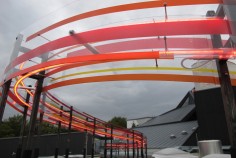Susanne Rottenbacher
source: voltashow
Susanne Rottenbacher is interested in science, especially into the rules of light. Her work is always about showing aspects of sciences combined with the freedom of art. Using wire structures, LEDs, foam, painted stripes, acrylic glass, and colored foil, the artist conjures synthetic landscapes that interact with the natural times of day and weather conditions. Susanne Rottenbacher lives and works in Berlin.
.
.
.
.
.
.
.
source: voltashow
Born 1969 in Göttingen, Germany
Susanne Rottenbacher began her career studying stage and light design at Columbia University in New York and the Bartlett School of Architecture and Planning in London. After working as a stage designer at the Deutsche Oper Berlin, she has been focusing on light art since 2004. Rottenbacher’s sculptures breathe the spirit of the kinetic art of the 1960s. In the early stages of her career she used the elements painting, light, and time in her work with acrylic boxes, and in recent years transparent circles of light have become the Berlin artist’s trademark. Since this year, Susanne Rottenbacher´s work bursts out of its formal frame and is now able to appear in a much freer context.
Inside the transparent plastic objects a filigree wire structure is trimmed with small, coloured LED-lamps. The outside is painted with stripes of differing colour intensity, widths and density. Rottenbacher’s installations also unfold their full potential in the public space, such as the Lichtparcours (light course) in Braunschweig, Germany in 2010. The rings exude a magical, almost psychedelic atmosphere at night when they shine as light- and colour-objects in the dark.
Hanging freely and in groups or put up in fixed ensembles, the objects face the observer as figures that reach out into the space around them with varying direction, size and density.
.
.
.
.
.
.
.
source: lichtberlinde
Susanne Rottenbacher wurde 1969 in Göttingen geboren und lebt in Berlin. Rottenbachers farbige Lichtinstallationen beruhen auf dem Prinzip der Wechselwirkung zweier Farbebenen.
Eine immaterielle und eine materielle Farbebene werden miteinander in Beziehung gesetzt. Die beiden Farbebenen treten im Tag-Nacht-Zyklus ohne künstliche Steuerung in ein natürliches Wechselspiel. Farbige Flächen am Tag werden bei Dunkelheit zu farbigen Räumen. Dabei wird das Phänomen Farblicht in seiner Materialität physisch erfahrbar. Besucher und Publikum finden sich in farbigen Lichträumen wieder und werden selbst zur Projektionsfläche von Licht
und Farbe. Diese Verschiebungen werden nicht durch Elektronik, sondern durch natürliche Abläufe gesteuert. Mit dem gezielten Weglassen jeder künstlichen elektronischen Steuerung thematisiert Rottenbacher Natur, natürliche Abläufe sowie das Verständnis von Natur und des natürlichen Lebensraums.


